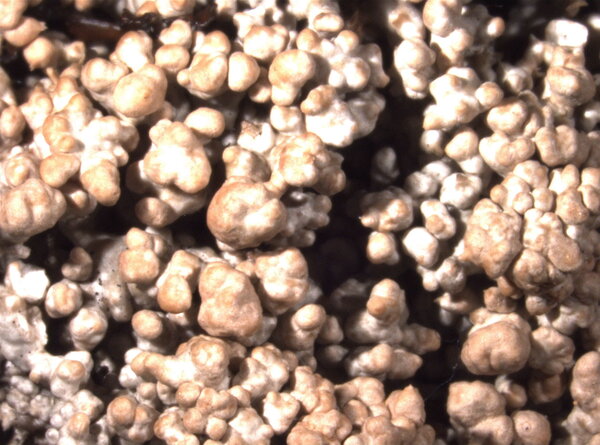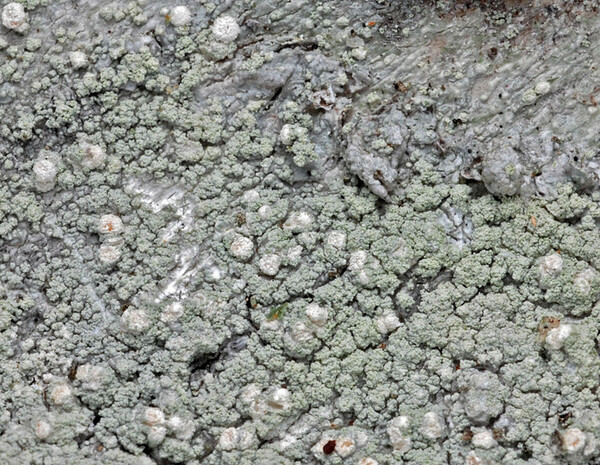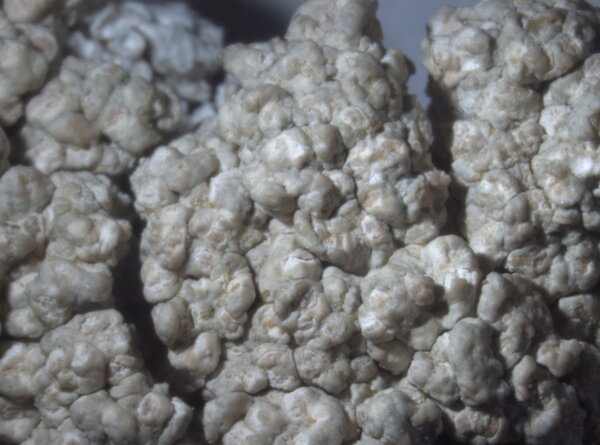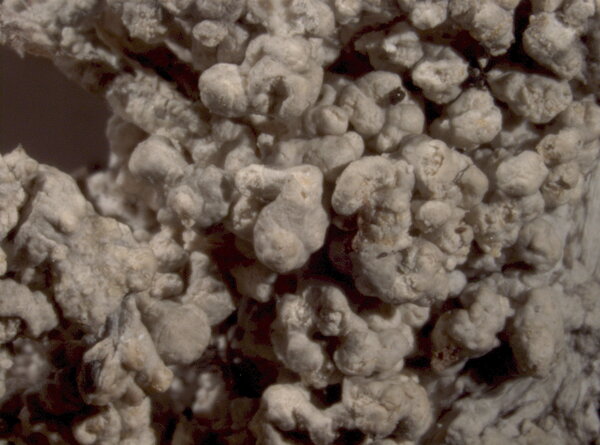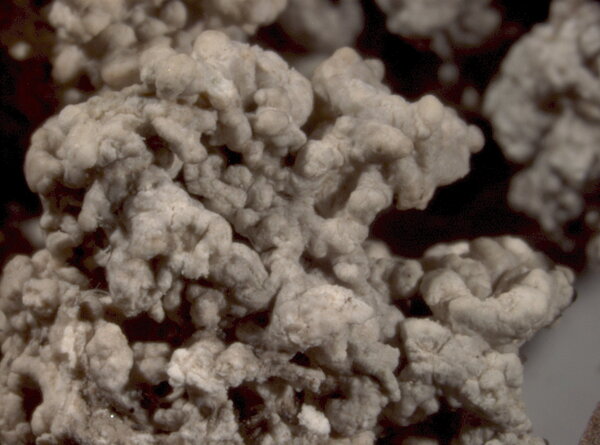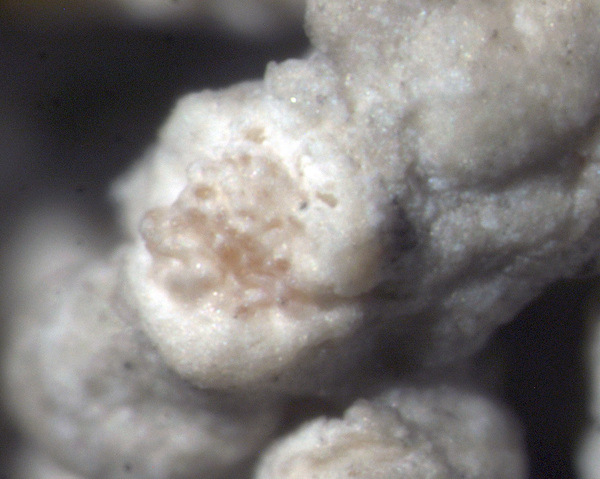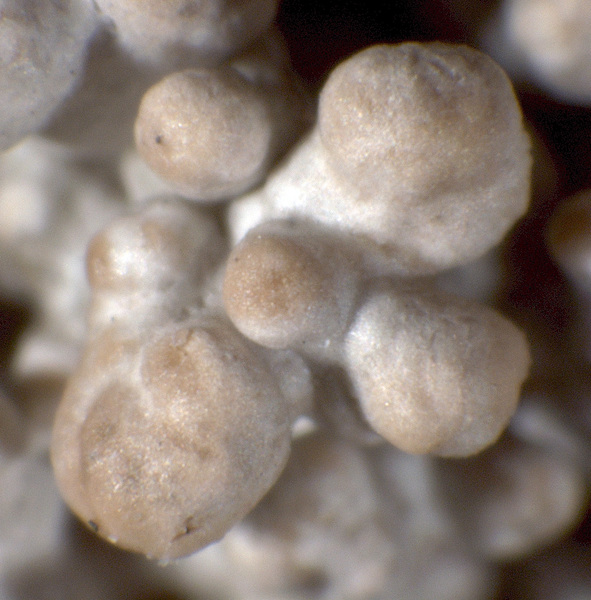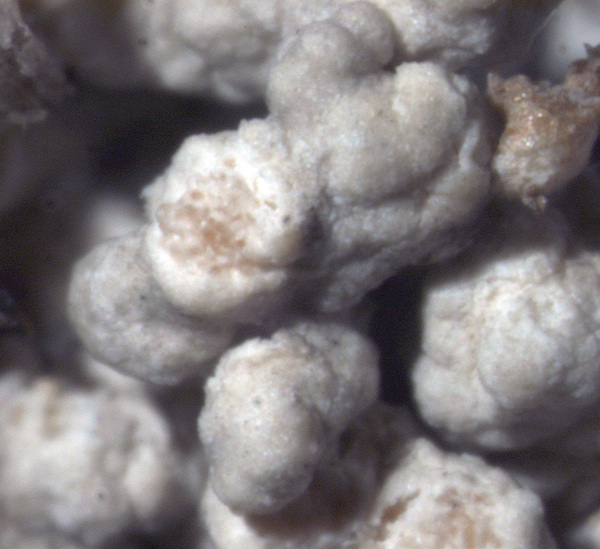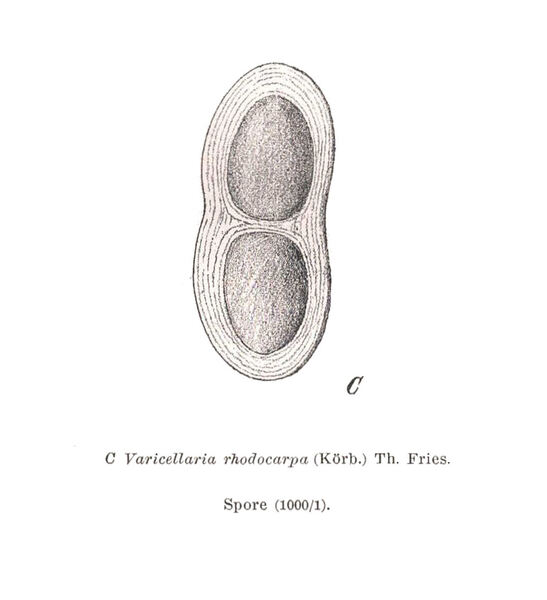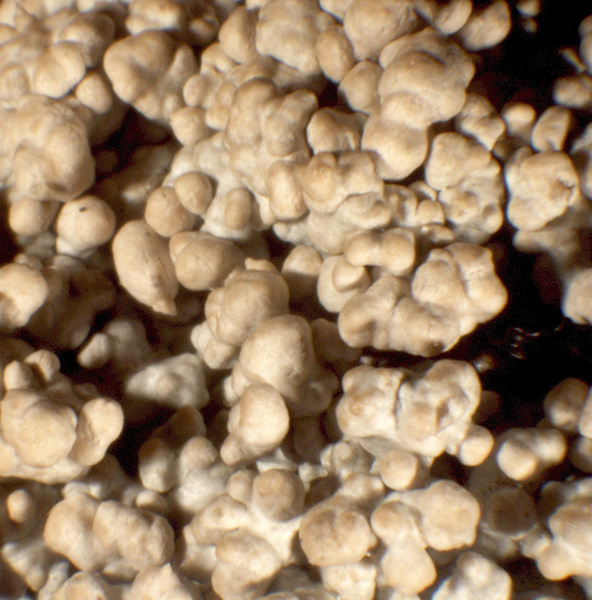Varicellaria rhodocarpa (Körb.) Th. Fr.
Lichenogr. Scand., 1: 322, 1871. Basionym: Pertusaria rhodocarpa Körb. - Syst. Lich. Germ.: 384, 1855.
Synonyms: Varicellaria kemensis Räsänen; Varicellaria microsticta Nyl.
Distribution: N - Frl, Ven, TAA (Hinteregger 1994, Nascimbene & al. 2022), Lomb, VA (Nascimbene & al. 2021). C - Tosc (Jatta 1909-1911).
Description: Thallus crustose, usually episubstratic, whitish, yellowish or rarely dark grey, smooth to irregularly granular-warty, often forming large patches. Soralia not always developed, grey to cream-coloured, bursting from the warts, at first small, round to elongate, later enlarging and becoming subcapitate, finally often confluent and forming a continuous sorediate crust. Cortex thin, cartilaginous, paraplectenchymatous, of thick-walled, agglutinated hyphae; medulla white, of periclinally arranged hyphae. Apothecia immersed in 0.5-1.2 mm broad, hemispherical thalline warts, with 2-3 round or irregular, reddish or yellowish, slightly convex, often pruinose discs, sometimes the tip of asci visible in the wet state as darker, more gelatinous dots. Epithecium pale, K-; hymenium colourless, usually more than 200 μm high, non-amyloid; paraphyses slender, 1.5-2 μm thick; hypothecium colourless. Asci 1-spored, broadly clavate, the apex without a distinct ocular chamber, the outer sheath K/I+ blue, otherwise K/I-, Pertusaria-type. Ascospores 1-septate, hyaline, ellipsoid, 200-400 x 70-140 μm, thick-walled, the outer walls lamellate and radially striate, to 25 μm thick, the inner wall thin; ascospore walls faintly amyloid. Photobiont chlorococcoid. Spot tests: thallus and especially medulla and soredia K-, C+ carmine-red, KC+ carmine-red, P-, UV+ yellowish, especially in sun-exposed parts, rarely UV+ bluish white. Chemistry: lecanoric acid, lichexanthone.Note: a mainly arctic-alpine species found on acid soil and plant remains, more rarely on lignum or on rocks in tundra-like environments near or above treeline; restricted to the Alps and the Northern Apennines in Italy.
Growth form: Crustose
Substrata: lignum, rocks, soil, terricolous mosses, and plant debris
Photobiont: green algae other than Trentepohlia
Reproductive strategy: mainly asexual, by soredia, or soredia-like structures (e.g. blastidia)
Commonnes-rarity: (info)
Alpine belt: rather rare
Subalpine belt: very rare
Oromediterranean belt: absent
Montane belt: absent
Submediterranean belt: absent
Padanian area: absent
Humid submediterranean belt: absent
Humid mediterranean belt: absent
Dry mediterranean belt: absent
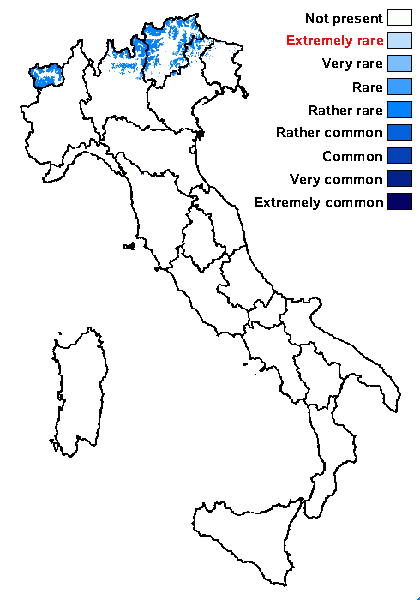
Predictive model
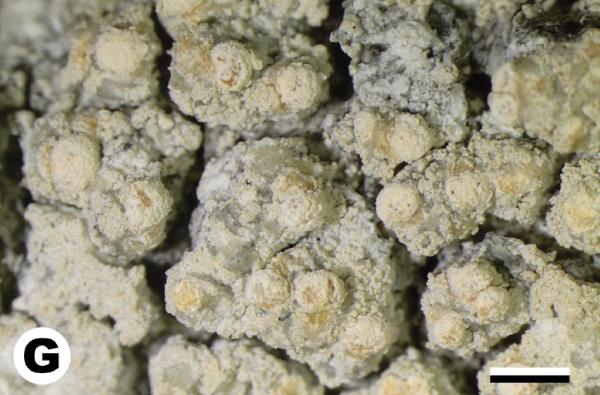
Source: Schmitt I, Otte J, Parnmen S, Sadowska-Deś A, Luecking R, Lumbsch T (2012) A new circumscription of the genus Varicellaria (Pertusariales, Ascomycota). MycoKeys 4: 23-36. - CC BY-4.0
Sweden, Printzen 6908 (FR)
Scale bar: 1mm. Images were taken with an Olympus SC30 camera under an Olympus SZX7 stereomicroscope.


P.L.Nimis; Owner: Department of Life Sciences, University of Trieste
Herbarium: TSB (36935)
2008.02.23
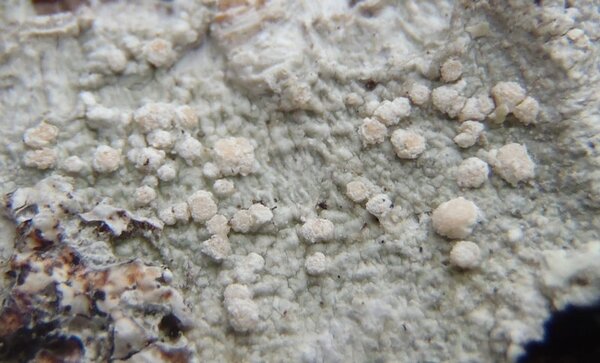

Curtis Randall Björk – CC BY-SA 4.0
British Columbia, Clearwater Valley Date: 2014-04-07 On Alnus in mixed conifer-deciduous forest
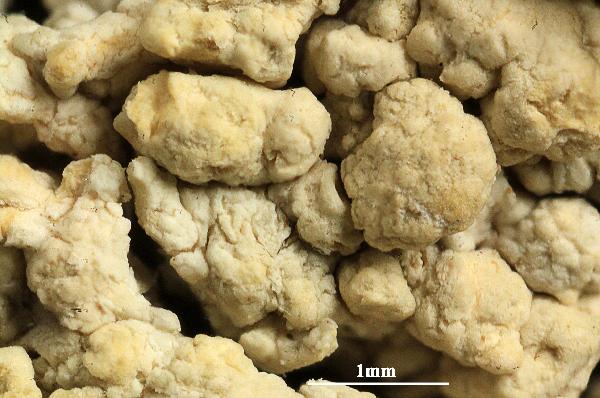

Felix Schumm - CC BY-SA 4.0
[20960], Austria, Steiermark (=Styria), Eastern Alps, Styrian Fringe
Mountains, Stubalpe, 18.2 km west of the centre of Köflach, 2.4 km
southwest of Hirscheggersattel (Salztiegelhaus), summit area of Speikogel,
47°03'06'' N, 14°15'30'' E. 1980 m. windblown ridge, on plant
remnants of vascular plants and bryophytes. Leg et det. W. Oberweyer
(13927), 21.10.2017. TLC: lecanoric acid, lichexanthone, anal. W.
Obermeyer. - EX W. OBERMEYER 2017: DUPLA GRAECENSIS LICHENUM
NR. 1190).
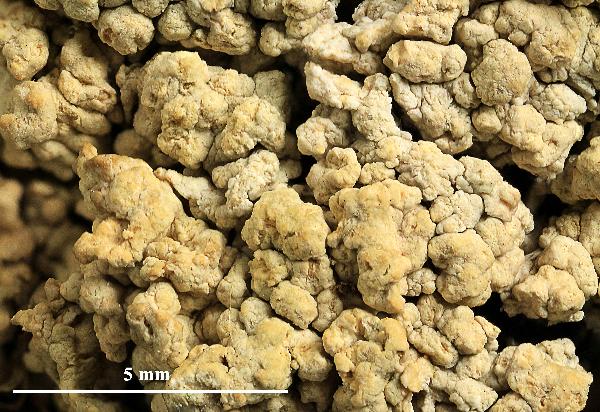

Felix Schumm - CC BY-SA 4.0
[20960], Austria, Steiermark (=Styria), Eastern Alps, Styrian Fringe
Mountains, Stubalpe, 18.2 km west of the centre of Köflach, 2.4 km
southwest of Hirscheggersattel (Salztiegelhaus), summit area of Speikogel,
47°03'06'' N, 14°15'30'' E. 1980 m. windblown ridge, on plant
remnants of vascular plants and bryophytes. Leg et det. W. Oberweyer
(13927), 21.10.2017. TLC: lecanoric acid, lichexanthone, anal. W.
Obermeyer. - EX W. OBERMEYER 2017: DUPLA GRAECENSIS LICHENUM
NR. 1190).

Erichsen C.F.E. 1936. Pertusariaceae. - In: Dr. L. Rabenhorsts Kryptogamenflora von Deutschland, Österreich und der Schweiz. Bd. IX, Abt. 5, T. 1. Akad. Verlagsges., Leipzig, pp. 321-512, 513-728. - Public Domain
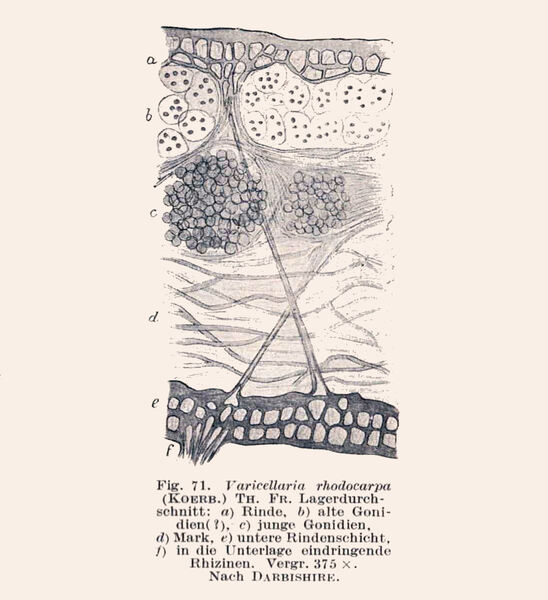
Erichsen C.F.E. 1936. Pertusariaceae. - In: Dr. L. Rabenhorsts Kryptogamenflora von Deutschland, Österreich und der Schweiz. Bd. IX, Abt. 5, T. 1. Akad. Verlagsges., Leipzig, pp. 321-512, 513-728. - Public Domain
Growth form: Crustose
Substrata: lignum, rocks, soil, terricolous mosses, and plant debris
Photobiont: green algae other than Trentepohlia
Reproductive strategy: mainly asexual, by soredia, or soredia-like structures (e.g. blastidia)
Commonnes-rarity: (info)
Alpine belt: rather rare
Subalpine belt: very rare
Oromediterranean belt: absent
Montane belt: absent
Submediterranean belt: absent
Padanian area: absent
Humid submediterranean belt: absent
Humid mediterranean belt: absent
Dry mediterranean belt: absent

Predictive model

Source: Schmitt I, Otte J, Parnmen S, Sadowska-Deś A, Luecking R, Lumbsch T (2012) A new circumscription of the genus Varicellaria (Pertusariales, Ascomycota). MycoKeys 4: 23-36. - CC BY-4.0
Sweden, Printzen 6908 (FR)
Scale bar: 1mm. Images were taken with an Olympus SC30 camera under an Olympus SZX7 stereomicroscope.


P.L.Nimis; Owner: Department of Life Sciences, University of Trieste
Herbarium: TSB (36935)
2008.02.23


Curtis Randall Björk – CC BY-SA 4.0
British Columbia, Clearwater Valley Date: 2014-04-07 On Alnus in mixed conifer-deciduous forest


Felix Schumm - CC BY-SA 4.0
[20960], Austria, Steiermark (=Styria), Eastern Alps, Styrian Fringe Mountains, Stubalpe, 18.2 km west of the centre of Köflach, 2.4 km southwest of Hirscheggersattel (Salztiegelhaus), summit area of Speikogel, 47°03'06'' N, 14°15'30'' E. 1980 m. windblown ridge, on plant remnants of vascular plants and bryophytes. Leg et det. W. Oberweyer (13927), 21.10.2017. TLC: lecanoric acid, lichexanthone, anal. W. Obermeyer. - EX W. OBERMEYER 2017: DUPLA GRAECENSIS LICHENUM NR. 1190).


Felix Schumm - CC BY-SA 4.0
[20960], Austria, Steiermark (=Styria), Eastern Alps, Styrian Fringe Mountains, Stubalpe, 18.2 km west of the centre of Köflach, 2.4 km southwest of Hirscheggersattel (Salztiegelhaus), summit area of Speikogel, 47°03'06'' N, 14°15'30'' E. 1980 m. windblown ridge, on plant remnants of vascular plants and bryophytes. Leg et det. W. Oberweyer (13927), 21.10.2017. TLC: lecanoric acid, lichexanthone, anal. W. Obermeyer. - EX W. OBERMEYER 2017: DUPLA GRAECENSIS LICHENUM NR. 1190).

Erichsen C.F.E. 1936. Pertusariaceae. - In: Dr. L. Rabenhorsts Kryptogamenflora von Deutschland, Österreich und der Schweiz. Bd. IX, Abt. 5, T. 1. Akad. Verlagsges., Leipzig, pp. 321-512, 513-728. - Public Domain

 INDEX FUNGORUM
INDEX FUNGORUM
 GBIF
GBIF
 DOLICHENS
DOLICHENS
